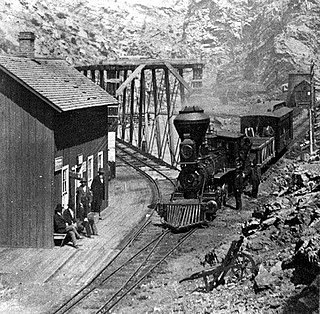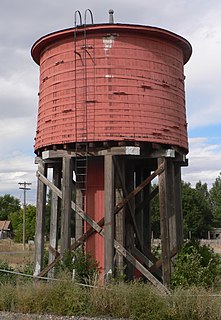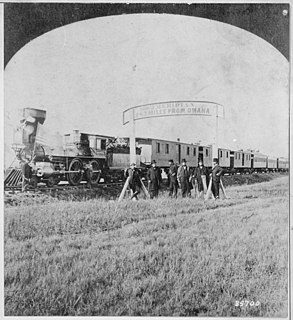Related Research Articles

The First Transcontinental Railroad was a 1,912-mile (3,077 km) continuous railroad line constructed between 1863 and 1869 that connected the existing eastern U.S. rail network at Council Bluffs, Iowa with the Pacific coast at the Oakland Long Wharf on San Francisco Bay. The rail line was built by three private companies over public lands provided by extensive US land grants. Construction was financed by both state and US government subsidy bonds as well as by company issued mortgage bonds. The Western Pacific Railroad Company built 132 mi (212 km) of track from the road's western terminus at Alameda/Oakland to Sacramento, California. The Central Pacific Railroad Company of California (CPRR) constructed 690 mi (1,110 km) eastward from Sacramento to Promontory Summit, Utah Territory. The Union Pacific Railroad (UPRR) built 1,085 mi (1,746 km) from the road's eastern terminus at the Missouri River settlements of Council Bluffs and Omaha, Nebraska westward to Promontory Summit.

Douglas is a city in Converse County, Wyoming, United States. The population was 6,120 at the 2010 census. It is the county seat of Converse County and the home of the Wyoming State Fair.

The Platte River is a major river in the State of Nebraska. It is about 310 mi (500 km) long; measured to its farthest source via its tributary the North Platte River, it flows for over 1,050 miles (1,690 km). The Platte River is a tributary of the Missouri River, which itself is a tributary of the Mississippi River which flows to the Gulf of Mexico. The Platte over most of its length is a broad, shallow, meandering stream with a sandy bottom and many islands—a braided stream.

The Chicago and North Western Transportation Company was a Class I railroad in the Midwestern United States. It was also known as the "North Western". The railroad operated more than 5,000 miles (8,000 km) of track as of the turn of the 20th century, and over 12,000 miles (19,000 km) of track in seven states before retrenchment in the late 1970s. Until 1972, when the employees purchased the company, it was named the Chicago and North Western Railway.

The Colorado Central Railroad was a U.S. railroad company that operated in Colorado and southeastern Wyoming in the late 19th century. It was founded in the Colorado Territory in the wake of the Colorado Gold Rush to ship gold from the mountains. It expanded from its Golden–Denver line to form a crucial link connecting Colorado with the transcontinental railroad and the national rail network. The history of the railroad throughout the 1870s was driven at times by a fierce struggle between local interests, led by W.A.H. Loveland, and outside investors of the Union Pacific Railroad led at times by Jay Gould. The early struggle of the company to build its lines was a major part of the early competition between Denver and Golden for supremacy as the principal metropolis of Colorado.
The Denver Pacific Railway was a historic railroad that operated in the western United States during the late 19th century. Formed in 1867 in the Colorado Territory, the company operated lines in Colorado and present-day southeastern Wyoming in the 1870s until merging with the Kansas Pacific and Union Pacific railroads in 1880. The railroad was formed primarily to create a link between Denver and the transcontinental railroad at Cheyenne, an achievement that was widely credited at the time with making Denver the dominant metropolis of the region.
The Kansas Pacific Railway (KP) was a historic railroad company that operated in the western United States in the late 19th century. It was a federally chartered railroad, backed with government land grants. At a time when the first transcontinental railroad was being constructed by the Central Pacific and the Union Pacific, it tried and failed to join the transcontinental ranks. It was originally the "Union Pacific, Eastern Division", although it was completely independent. The Pennsylvania Railroad, working with Missouri financiers, designed it as a feeder line to the transcontinental system. The owners lobbied heavily in Washington for money to build a railroad from Kansas City to Colorado, and then to California. It failed to get funding to go west of Colorado. It operated many of the first long-distance lines in the state of Kansas in the 1870s, extending the national railway network westward across that state and into Colorado. Its main line furnished a principal transportation route that opened up settlement of the central Great Plains, and its link from Kansas City to Denver provided the last link in the coast-to-coast railway network in 1870. The railroad was consolidated with the Union Pacific in 1880, and its mainline continues to be an integral part of the Union Pacific network today.

The Laramie Plains is an arid highland at an elevation of approx. 8,000 feet (2,400 m) in south central Wyoming in the United States. The plains extend along the upper basin of the Laramie River on the east side of the Medicine Bow Range. The city of Laramie is the largest community in the valley. The plains are separated from the Great Plains to the east by the Laramie Mountains, a spur of the Front Range that extends northward from Larimer County, Colorado west of Cheyenne. The high altitude of the region makes for a cold climate and a relatively short growing season. Unsuitable to most cultivation, the plains have historically been used for livestock raising, primarily of sheep and cattle.
The Fremont, Elkhorn and Missouri Valley Railroad (FE&MV), sometimes called "the Elkhorn," was a railroad established in 1869 in the state of Nebraska in the Midwestern United States.
The Fremont and Elkhorn Valley Railroad was a 17-mile (27 km) heritage railroad headquartered in Dodge County, Nebraska and, offered excursion services on the line. Its equipment is now owned by the Nebraska Railroad Museum.
Charles Henry King was an Omaha businessman and banker who was instrumental in founding several cities in the states of Nebraska and Wyoming. He saw opportunity with the expansion of the railroad west and built up related retail businesses, banks and freight operations. His fortune was estimated at $20 million. He was also the paternal grandfather of U.S. President Gerald Ford, who was born in his home in Omaha.
Interstate 25 (I-25) is a part of the Interstate Highway System that runs from Las Cruces, New Mexico, to Buffalo, Wyoming. In Wyoming, the Interstate Highway runs 300.530 miles (483.656 km) from the Colorado state line near Cheyenne north to its national terminus at I-90 near Buffalo. I-25 connects Wyoming's largest city and capital, Cheyenne, with its second largest city, Casper, and the smaller communities of Wheatland, Douglas, and Buffalo. The highway also connects those cities with Denver and Billings via I-90. I-25 runs concurrently with U.S. Route 87 for almost its entire course in Wyoming. The highway also has extensive concurrencies with US 20 and US 26 along its east–west segment through the North Platte River valley. The Interstate has business loops through Cheyenne, Chugwater, Wheatland, Douglas, Glenrock, Casper, and Buffalo.
The Sioux City and Pacific Railroad was a railroad in the U.S. states of Iowa and Nebraska. Built as a connection from Sioux City, Iowa to the Union Pacific Railroad at Fremont, Nebraska, it became part of the Chicago and North Western Railway system in the 1880s, and is now a main line of the Union Pacific (UP). The east-west portion from Fremont to Missouri Valley, Iowa, is the Blair Subdivision, carrying mainly westbound UP trains, and the line from California Junction, Iowa north to Sioux City is the Sioux City Subdivision.

The Lusk Water Tower was built in 1886 to provide water for steam locomotives on the former Fremont, Elkhorn and Missouri Valley Railroad, at Lusk, Wyoming. Lusk itself was built by the railroad at the same time. The tank was originally located in the middle of Lusk near the railroad depot and was moved in 1919 to the present site on the east edge of town, adjacent to what became the Chicago and North Western Transportation Company line now owned by Union Pacific.
The Cheyenne and Northern Railway was a railroad in the U.S. state of Wyoming. The railroad was incorporated in 1886 to build a line from Cheyenne, Wyoming into northern Wyoming and Montana. The line extended 125 miles (201 km) to Wendover on the North Platte River. It was absorbed by Union Pacific Railroad subsidiary Union Pacific, Denver and Gulf Railway and later became part of the Colorado and Southern Railway when the Union Pacific went into receivership.

Lusk is a high-plains town in the eastern part of the state of Wyoming. The town is the seat of Niobrara County. The town was founded in July 1886, by Frank S. Lusk, a renowned Wyoming rancher, partner in the Western Live Stock Company, and stockholder in the Wyoming Central Railway. Cattle ranching remains the primary industry in the town of Lusk.
The history of rail transportation in Colorado began with the competition between two separate railways in the late 1860s the Denver Pacific Railroad and the Colorado Central and Pacific Railroad. Following the decision of the Union Pacific Railroad to route the transcontinental railroad through Cheyenne, Wyoming instead of Denver, the first town in the Front Range area to construct a connecting line to the Union Pacific Railroad would more naturally become the economic focus of the Colorado territory. The Colorado Central and Pacific Railway was incorporated in 1865 by residents of Golden, however this railway was unable to immediately begin constructing a connecting line to Cheyenne. The existence of the Colorado Central and Pacific Railroad prompted the citizens of Denver to incorporate the Denver Pacific Railroad on November 19, 1867. Following a spirited campaign raising capital, the Denver Pacific Railroad laid its first track in 1869. By June 26, 1870, the Denver Pacific Railroad was completed.

The history of the Union Pacific Railroad stretches from 1862 to the present. For operations of the current railroad, see Union Pacific Railroad; for the holding company that owns the current railroad, see Union Pacific Corporation.

The Fremont, Elkhorn & Missouri Valley Railroad Passenger Depot, also known as the Chicago and North Western Railway Passenger Depot and presently as the Douglas Railroad Interpretive Center, was built in 1886 in Douglas, Wyoming to accommodate traffic on the Fremont, Elkhorn and Missouri Valley Railroad's (FE&MV) terminus at the newly built town. The depot was built as a fairly small, cautious investment in a possibly ephemeral frontier town. Immediately following the completion of the depot Douglas saw an epidemic of typhoid fever and the worst winter in a generation, and the railroad decided to push on to Casper for its terminus. The town's population declined from 1600 in 1886 to 900 in 1888. By 1891 Owen Wister reported that Douglas had a population of about 350. However, by 1910 Douglas had 2246 residents and hosted the Wyoming State Fair. The presence of the fair stimulated rail traffic, while the FE&MV merged with the Cheyenne and Northern Railway in 1903. In 1905 oil development started. In the 1950s coal mining began for the Dave Johnson Power Plant and the railway expanded its Douglas facilities to accommodate the traffic, closing the original depot and building a larger facility. The depot was acquired from the railroad's successor, the Chicago and North Western Railway, by the city in 1990.
References
- ↑ Olinger, Ralph. "Early Livestock man, railroader".
- 1 2 3 "Historic American Engineering Record: Canyon Creek Bridge No. 294" (PDF).
- ↑ Athearn, Robert G. (1976). Union Pacific Country. University of Nebraska Press. p. 304. ISBN 978-0-8032-5829-7.